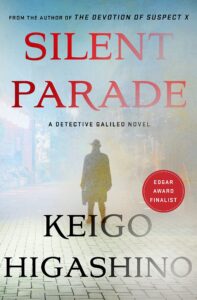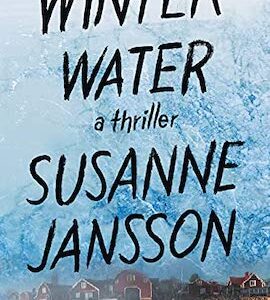Silent Parade by Keigo Higashino is set on a street of shops in Tokyo, not too different from the street where Newcomer takes place. What do Higashino’s books tell us about Tokyo and the people of Japan? I spoke with two of Higashino’s English-language translators, Giles Murray and Alexander O. Smith, about how the world in Higashino’s crime novels reflect the real Tokyo—how it feels, how it operates, and how it’s changing.
Giles Murray was born in the United Kingdom, lives in Tokyo, and has translated various works of Japanese fiction and non-fiction, notably by Tetsuya Honda and Keigo Higashino.
Alexander O. Smith was born in the United States, got his degrees at Dartmouth University (B.A.) and Harvard University (Masters) and lives with his family in Japan. He’s worked widely in video game localization (several of the Final Fantasy games among many others) and as a translator, including works by Miyuke Miyabi and Keigo Higashino.
Hector DeJean: First, if you’ve been to Tokyo, what are your impressions of the place? In terms of population, it’s the biggest city in the world, almost twice as populated as any of the largest cities in the Western Hemisphere; but in terms of area it’s dwarfed by places like Chicago and Dallas. What’s it like living in Tokyo? What makes it different from cities like New York and Paris?
Giles Murray: I suppose what makes Tokyo different is that, with the possible exception of the rush hour trains, everyone is very polite all the time, in a rather quaint, St. Mary Mead way. It is not accepted wisdom, as it is in many big cities in the West, that stress confers the automatic right to be rude and impatient. Tokyo is very dense, with lots of houses all sitting on top of one another, and lots of clearly defined areas centered around subway and railways stations. The area around and leading to the station will be chock-a-block with shops, restaurants etc., many of which will be family run, and this will help foster a sense of community. (The city has all the boring brands like KFC, McDonalds etc., but people are not in thrall to them. Other than in really godforsaken dormitory towns, they are not dominant, the way they are in the US and the UK.) Here’s a good example of the civility thing and the community thing: When I moved to Tokyo in 1991, I had no money. One way to save money was to rent an apartment with no bath or shower and instead use the sento, or public bath. I recall being astounded to see young women walking to and fro the bath with their senmenki (washing bowl) in their pajamas at night. They did not expect to be wolf-whistled at or otherwise molested and they weren’t. The existence of a clear social structure with people in different professions is reminiscent of golden age thrillers, but at a more bourgeois level. Whodunnit? Is it the vicar in the library? Is it the lady of the manor in her garden? No, it’s the ramen chef under the railway line or the watch-seller in the local park.
Q: The impression I get from reading Higashino’s novels—especially Newcomer and Silent Parade—is that Tokyo has several streets lined with smallish mom-and-pop stores and businesses—restaurants, cafes, handcrafted goods, electronics sales and repair, that kind of thing. Is that accurate? Do you know of such places in Japan?
GM: That’s right. There is always something called a shotengai, a shopping street or series of shopping streets, sometimes covered with an arcade for protection from the rain, near any station. Over the last few decades, some of these shops have come under pressure and are starting to shut down rather than be passed down to the next generation of the family. Things like home electronics, white goods or watches are nearly all sold in so-called “category killer” (big box?) stores, making the equivalent mom-and-pop stores uncompetitive on price and selection. Obviously, the Internet, department stores strategically located near the station, as well as changes in taste are all putting pressure on mom-and-pop stores, making them feel increasingly anachronistic. That means these mom-and-pop shops are becoming less common, though privately run restaurants continue to flourish in large numbers, as do more specialized/less generic shops.
Alex O. Smith: As Giles notes, Tokyo has managed to hold onto its neighborhood feel, and when places gentrify, they tend to gentrify in a way that leaves them with an individual character. I wonder if this isn’t because Tokyo has completely rebuilt itself twice in the last 100 years or so, once after the 1923 earthquake and again after the Allied firebombing in WW2. There was another sweeping project of demolition and construction for the 1964 Olympics, and smaller scale rebuilding takes place on a regular basis as post-war concrete block structures dotting the city are gradually replaced by a jumble of architectural styles. Each time one of these cycles of rebuilding comes along, the metropolitan government attempts large-scale projects of the kind that resulted in rows of brownstones, or the arrondissement apartments of NYC and Paris, and each time they’re thwarted by strong neighborhood communities, or organized crime, which are sometimes one and the same.
Q: Do you think Higashino makes such areas central to his books because he wants to provide readers with an accurate description of Tokyo? Or is he trying to preserve an aspect of the city that’s disappearing and which most residents don’t encounter any more?
GM: I think the books centered on Nihonbashi do have a deliberate and self-conscious element of nostalgia. Nihonbashi is the official geographic center of Japan and one of the oldest parts of Tokyo inhabited by “Edoko” (traditional Tokyoites) and as such it has a special significance for Higashino and his Japanese readers, hearkening back to a more innocent past. The Ningyocho area (where Newcomer and Wings of the Kirin are set) in Nihonbashi has turned its olde worlde charms into a selling point and people go there for the restaurants etc. There are even Higashino trails you can do, visiting shops and restaurants that appear in his books, so there is a degree of self-awareness on both sides. As for accuracy, generally the streets, shops etc. are all based on what is actually there, which is why I send in a bunch of photos with the translated text to help the editor envisage what Higashino is writing about.
AS: You can find a similar nostalgia in books like A Midsummer’s Equation, in which the detective has to trace one of the character’s movements in the past through an area called Sanya, which was the old day-laborer, flophouse region in Tokyo that no longer exists.
Q: Silent Parade features a festival that’s not just specific to a ‘borough’ of Tokyo (if Tokyo has anything like boroughs), but to a neighborhood. Do many neighborhoods in Tokyo and Japan have such festivals, where locals participate with floats and costumes?
GM: The festival in Silent Parade is, if I remember rightly, a new and artificial creation designed to bring in tourists. But yes, all districts of towns and cities in Japan have a local festival in the summer, usually with a portable shrine being bounced around on the shoulders of grunting young men in traditional costumes, and large amounts of beer and snacks consumed. The festivals, as happens in SP, are organized by the local great and good (often shopkeepers, the local chamber of commerce, as it were). Some of these festivals are quite distinctive. Many festivals in Okinawa, for example, involve a tug of war with tens or even a hundred or more people pulling on a colossal rope made from rice ears. The Westerners get very excited about the penis festival which is held somewhere on (I think) the outskirts of Tokyo. So the idea of having a local summer festival with a distinctive theme is very deep-rooted.
Q: My impression—and it may be utterly wrong—of Japanese society is that is it very stratified by class, with rules of etiquette for how members of different classes interact with each other. In Higashino’s books you have Detective Galileo, a college professor, working with police officers, who probably aren’t in the same social strata as him, and investigating crimes among restaurant owners and truck drivers. Are there elements of social inequality in Higashino’s books, or am I just looking for something that isn’t there?
GM: I would say you are looking for something that isn’t there. Although Japan does not have the greatest Gini coefficient and suffers from child poverty, it is very far from the ghastly vision of society envisaged by someone like Tyler Cowen, who sees a future in which Goldman Sachs bankers earn millions and the rest of us just scramble desperately in their wake, begging to be allowed to cut their toenails or wash their hair. In Japan, if you do your job well, then you have no reason to think ill of yourself. People have a lot of self-respect. It is your seriousness and competence that define you. “Be all you can be” whatever that may be. Coming from England, I marvel at how little class friction there is. In part, I suppose, this is because you do not find yourself in automatic conflict with your builder, painter, train conductor etc. because they are all honest, competent and civil. As a result, antagonism is not the starting point of every interaction. No, the idea that society splits into “Masters of the Universe” and a resentful everyone else does not really apply in Japan, thank goodness. I suppose Galileo is treated with respect because he is a sensei (teacher), but you could see that as the expression of a wholesome Confucian deference for education in the abstract rather than an example of an oppressive power vertical. There is certainly a slightly rougher strata of people doing physical labor, but even there the idea that being lazy, feckless and irresponsible is a natural right because the world is unfair simply doesn’t hold. You do your job, I’ll do mine and we all get along fine. I suppose the one aspect of social inequality you might find in Higashino’s books is the idea that people who are unemployed or move from job to job with no fixed abode (like the killer in SP, or the killer in When the Final Curtain Falls, which I am currently translating) are fundamentally untrustworthy. It’s a bit of a locus classicus in Japanese news for someone mushoku (unemployed and therefore necessarily “bad”) to kill a kaishain (company employee and therefore necessarily “good”).
AS: Two of the Higashino books I translated, Malice and Under the Midnight Sun, delve a bit into the social strata, but while Malice seems to use it merely as a way to spice up an investigation by giving a variety of people for the detective to talk to, the gap between the classes makes up the fabric of Midnight Sun’s story, with the antagonist self-identifying as lower class, working at a pawn shop and at various criminal enterprises, and watching as his girlfriend Yukiho uses her looks to trade up and work her way out of the poverty where she began. While in general, there is far less class friction in Japan than you typically expect to find in the West (especially from the lower middle class up—there’s very little sense of a class separation between a civil servant, like a police officer, and a university professor), I think Higashino takes particular interest in the stories of those mushoku outsiders who tend to come from a lower-class background.
***


















